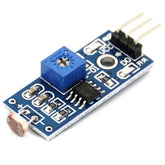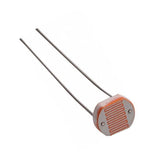What is a Light Sensor? - Types, Uses, Arduino Guide
Summary
Do you want to unlock the Power of Light with Light Sensors - An In-Depth Guide. From principles and types to advantages and applications, discover everything you need to know about light sensors. Unleash the potential of light sensing technology in your projects with the help of Arduino. Get ready to shed light on the world of light sensors!
Introduction
Light sensors are one of the most essential components used in automation. They detect and measure light levels from natural or artificial sources for a variety of applications.
Used widely across industries, they can be found in home security systems, medical devices, automotive sector and other areas where motion detection is needed.
A photodiode or photocell is the main element behind this technology that detects any changes to its environment via incoming photons from external sources which cause current flow through circuits attached to them thus alerting users about sudden movements around it.
Light sensors offer many advantages such as increased safety by detecting intrusion into protected zones when integrated with alarm systems; low power consumption allowing long-term usage; improved system efficiency through optimized use of energy resources ; accurate measurements even under low lighting conditions coupled with efficient utilization due being very economical compared to traditional methods making them an attractive choice for various customer segments.
What is a Light Sensor?
A sensor is a device that transforms sensed signal into an understandable or measurable signal. A device that, strictly speaking, senses the measurement and converts it into an output signal of the same or a different character.
A sensor consists of an auxiliary power source, a measuring circuit, a conversion element, and a sensor element. Some sensors don't need an external power source like passive sensors.
In today's culture, light sensors are everywhere for example Bar code readers, laser printers, and autofocusing microscopes are a few examples of applications that use reflected light in conjunction with optical detection to determine position.
Optical sensors are used in other software applications, like digital cameras, mobile phones, and laptops, to measure ambient light levels.

A light sensor called a photoelectric device transforms the observed light energy (photons) into electrical energy (electrons). It appears in a variety of forms and is employed in numerous contexts.
The photoelectric effect theory of semiconductors is the foundation upon which the light sensor was constructed. It can be used to measure ambient light intensity and the lighting variations caused by various coloured surfaces.
Users can use it to create projects that include light, such as intelligent dimming lights, a laser communication system, or something even cooler. Some of the most popular types of light intensity sensors include phototransistors, photoresistors, and photodiodes.
By sensing the radiant energy that exists in a relatively small range of frequencies often referred to as "light," which ranges in frequency from the "Infra-red" to "Visible" up to "Ultraviolet" light spectrum, a light sensor produces an output signal that indicates the intensity of light.
Principle of light sensor:
The light sensor is a passive component that produces an electrical signal from this "light energy," whether it is in the visible or infrared portions of the spectrum.
Because they transform light energy (photons) into electricity, light sensors are more generally referred to as "Photoelectric Devices" or "Photo Sensors" (electrons).
Read our blog on LDR light sensor
Types of light sensors:
There are different types of light sensors available light sensors can be classified into four categories:
- Photo Emissive:-
- Photo Conductive
- Photo Voltaic Cell
- Photo Junction Devices
1. Photo Emissive Sensors:
Photo Emissive sensors are classified into two types vacuum type or gas-filled type. Typically, it has two electrodes: a cathode (K) and an anode (A).
The cathode is an alkali metal, such as sodium, potassium, or caesium, that is coated with a photosensitive material. It is typically coated with an antimony caesium alloy or a combination of bismuth, silver, oxygen, and caesium to have a to gain high current.
A straight wire consisting of nickel or platinum serves as the anode (A). The cathode (K) is facing the anode (A). Depending on whether it will be used with visible or ultraviolet light, these electrodes are sealed in an evacuated glass or quartz bulb.
The current is changed as the photo-electrons move from the cathode to the anode because they ionise the gas inside.
The photo-electric current does not fluctuate linearly with the intensity of the light, which is the fundamental disadvantage of this type of cell.

2. Photo Conductive
This type of light sensor is also based on the principle of the inner photoelectric effect. A thin coating of semi-transparent metal is layered on top of a thin film of a semiconductor, such as selenium or thallium sulphide.
The mixture is placed on top of the iron block. Through battery and resistance, the transparent metal film is attached to the iron basis.
When a cell is illuminated, its resistance decreases, causing the external circuit's current to begin flowing.

The commonly used photoconductive cell is Light Dependent Sensor (LDR), Let's discuss the working principle of the LDR sensor.

The above-depicted circuits show the controlled circuit of the LDR. The base of the NPN transistor is fed with current from the centre of the potential divider in this circuit, which is formed by the LDR and the other resistor.
The resistance of the LDR rises as the light level falls. The voltage dropped across the LDR also rises as a result of this resistance's growth relative to the other resistor's fixed resistance.
When this voltage reaches a certain threshold (0.7V for a standard NPN transistor), the transistor will switch on. The LDR, transistor, and supply voltage all have an impact on the fixed resistor's value.

3. Photo Voltaic Cell

This is a type of sensor that generates e.m.f. without the application of any external potential difference but by only the light incident on it.
It consists of a semiconductor layer formed on the surface of the metal plate by either heat treatment or cathode sputtering. A film of semi-transparent metal is coated over the semiconductor.
This film maintains electrical contact with the semiconductor and simultaneously allows the incident light to fall on the semiconductor.
If the circuit's resistance is extremely low, the current will be inversely proportional to the brightness of the incident light. This cell's key benefit is that it can operate without external voltage.
This kind of cell is frequently seen in photometers, illumination metres, and exposure metres.
4. Photo Junction Devices:
These photodevices, which utilize light to control the flow of electrons and holes across their PN-junction, are mostly genuine semiconductor devices like photodiodes and phototransistors.
With their spectral response tailored to the wavelength of the incident light, photojunction devices are specifically made for detector applications and light penetration.
In essence, photojunction devices are silicon semiconductor PN-junction light sensors or detectors that are sensitive to light and can detect both visible light and infrared light levels.
The Photodiode and the Phototransistor are two types of photoelectric light sensors that are specifically designed for sensing light.
Photodiode is a PN Juction diode. Photons with sufficient energy impact a diode to produce electron-hole pairs.
Also known as the inner photoelectric effect, this mechanism. These carriers are swept away from the junction by the depletion region's built-in electric field if the absorption takes place there or one diffusion length is distant from it.
A photocurrent is created as a result of the movement of holes toward the anode and electrons toward the cathode.
To increase the device's sensitivity, the dark current must be kept to a minimum because it contributes to the overall current through the photodiode, which also includes the photocurrent.

One electron and one hole (a hole-electron pair) are produced for every photon in a photodiode, which immediately transforms photons into charge carriers.
The phototransistors are capable of providing current gain in addition to the aforementioned functions, increasing sensitivity significantly.
It operates as previously stated since the collector-base junction is a reverse-biased diode. A photoinduced current travels through the loop, which includes the base-emitter region if the transistor is coupled to a circuit that has a battery.
The transistor amplifies this current in a similar way to a standard transistor, which causes the collector current to increase significantly.

Advantages:
- LDR (or photoresistor)-based light sensors come in a variety of sizes and shapes.
- Light sensors just require a modest amount of voltage and power to function.
- Photoresistors have a reduced price, can operate in both directions, and have a medium response time.
- Photodiodes produce digital output, have a quick response time, and are less expensive.
- Compared to photoresistors, phototransistors are faster and give immediate output.
- Phototransistors produce more current than photodiodes do.
Disadvantages:
- LDRs have a long response time and are very imprecise.
- Photoresistor resistance varies continuously.
- Unlike photoresistors, which are bi-directional, photodiodes are temperature sensitive.
- Above 1000 volts, phototransistors are unable to sustain the voltage.
- Phototransistors are sensitive to spikes, surges, and electromagnetic energy.
Applications:
Mobile Phones: It is used for energy consumption or energy management by automatically controlling the brightness level in mobile phones and automatically ON/OFF of street lights based on ambient light intensity.
Automobiles: The current light sensor picks up ambient light from the environment and, if it becomes too dark, immediately activates the lighting systems. When it starts to rain or when you enter a tunnel, it is quite useful!
Security Applications: During shipping, light sensors are installed inside the container, coupled to circuits. Since the amount of light will change if a container is unintentionally opened, they can tell. By doing this, lost items and damages are reduced. In this situation, photoresistors are frequently utilised.
How to use the light sensor in the Arduino
There are two pins in the sensor one end of the LDR is connected to the 100K resistor followed by any analog pin in the Arduino. Another end of the LDR is connected to 3.3V or 5V. Another end of the resister is connected to GND. The connection diagram is shown below,

Open Arduino IDE and upload the below code to get LDR values.
Interfacing Arduino UNO with LDR sensor
const int ldrPin = A3; // analog pin A3
void setup() {
Serial.begin(9600);
pinMode(ldrPin, INPUT);
}
void loop() {
int ldrStatus = analogRead(ldrPin);
Serial.println("LDR value is : ");
Serial.print(ldrStatus);
delay(1000);
}
Conclusion
In this blog post, we have learnt that light sensors play a vital role in today's technology-driven world. Understanding the principles, types, advantages and applications of light sensors is crucial to utilize their full potential.
Whether you're looking to automate your home lighting system or integrate a light sensor into your latest Arduino project, this guide has provided you with all the information you need. So why wait? Start exploring the exciting world of light sensors today!
If you appreciate our work don't forget to share this post and leave your opinion in the comment box.
Please do check out other blog posts about Popular electronics
Make sure you check out our wide range of products and collections (we offer some exciting deals!)






